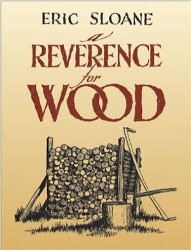A Reverence for Wood

Author:
Eric Sloane
Illustrator:
Eric Sloane
Publication:
1965 by Funk and Wagnalls
Genre:
Architecture, Art, Fiction, History, Hobbies and Handicrafts, Nature, Non-fiction
Pages:
111
Current state:
This book has been evaluated and information added. It has not been read and content considerations may not be complete.
Book Guide
Search for this book used on:
It might be that after we have spent a century or two in expending our wealth of wood to seek the riches of other planets, we will realize that our greatest wealth was right here on earth after all." This is the underlying theme of Eric Sloane's delightful new book, in which he relates, in text and illustrations, the important role wood has played in the development of our country.
To our forefathers, the vast, virgin forests were a source of income, shelter, food and medicine. Wood, however, was not merely a highly useful material, it was also an inspiration—gentle to the touch, exquisite to contemplate, tractable to creation, exciting to work with, and stronger by weight than iron. As William Penn said, "Wood is a substance with a soul."
The early American used wood to span rivers, make his tools, build and heat his home, fence his land, and build his barn. Man walked on wood, slept in it, sat on wooden chairs at wooden tables, and ate from wooden cups and dishes. From the cradle to the coffin—both made of wood—his life was surrounded by this precious commodity.
With characteristic ingenuity, the pioneer found uses for the by-products of wood. Charcoal was used to clean teeth, settle stomachs, sweeten breath, remove offensive odors, and to preserve meat. It was also used to make gunpowder, ink, paint, and medicine. Holly bark was used to relieve ague; swamp laurel to stop diarrhea; slippery elm for the cure of sore throats; black elder on skin infections; bayberry for the relief of dysentery; and ground aspen bark made a good substitute for quinine. A tree was depicted on our first coins and colonial flags—our forefathers' acknowledgment of their dependence on, and appreciation of, the forests.
This is a refreshing book—a book that treats with affection and wisdom the early American's resourcefulness and, by comparison, questions the value of this age's automation and computers, mass production and waste. Everyone will share the author's sentiments when he says, "Perhaps after reading this book, when you hear the rustling of leaves or the wind in the boughs, smell the fragrance of a Christmas tree or the burning of a pine log in the fireplace, or see the majesty of a gnarled and ancient oak, you will revive some faint memory from our early American heritage and share with those first settlers, a reverence for wood."
From the dust jacket
To view an example page please sign in.
Please sign in to access the type of illustrations and view more books with this type.

![]()
A Reverence for Wood
Reprinted in 2004 by Dover Publications
Available formats: Paperback
View on Amazon
To view reprints of this book please sign in.
Content Guide
Please sign in to access all of the topics associated with this book and view other books with the same topics.
Please sign in to access the locations this book takes place in and view other books in the same location.
Please sign in to access the time periods this book takes place in and view other books in the same time period.
Find This Book
Search for this book used on:


